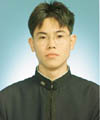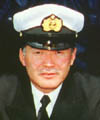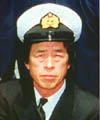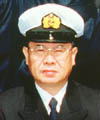Back home in Japan, life endures beyond anguish
| • | Ehime Maru: a year later |
| • | Greeneville incident alumni |
By Tanya Bricking
Advertiser Staff Writer
When Daisuke Shinoto looks out to the ocean, he tries not to be consumed by his past.
The victims of the Ehime Maru









For a 17-year-old, he already has lived through some serious turmoil.
Shinoto, who has lived in a southwestern Japanese orphanage since he was 6, survived the Ehime Maru shipwreck a year ago that took the lives of nine of his friends, teachers and other shipmates.
Since the collision of the submarine USS Greeneville with the fisheries school vessel off O'ahu one year ago tomorrow, he has transformed his grief into something more positive.
At home in Japan, when he looks out to the sea that fills the gap between his industrial harbor town of Uwajima and Hawai'i, he imagines his future.
He wants to return to Hawai'i someday, perhaps as the engineer of a ship.
"I still have a poor appetite and feel depressed sometimes," said Shinoto, a quiet young man who still has nightmares about the shipwreck. "But I can sleep at night and go to school every day. It's about time to decide on the courses to take after graduation in March. I hope to go to college to study ship engines."
Thirty-five people were aboard the Ehime Maru the day it was hit. They were men like Hiroshi Nishida, a 49-year-old engineer who went down with the ship, and boys like Shinoto who were on a field trip to learn the skills of generations of Uwajima fishermen.
Twenty-six boys and sailors scrambled to life rafts one year ago. They included nine students from Uwajima Fisheries High School's second-year ocean engineering class. They were boys who went home without four classmates, two teachers and three crewmen.
The survivors heard accounts of the U.S. Navy's recovery effort from afar. It was an unprecedented $60 million project that involved internationally known specialists and divers who were able to recover eight victims' remains.
Recovery meant families finally were able to perform Buddhist funeral rituals. Survivors in Japan held a memorial service just last month.
Closure is not the right word to describe what has changed in a year for survivors of the Ehime Maru.
But a feeling has returned to Uwajima that life endures.
"I still feel sad about the accident, but we must move on," said Ietaka Horita, principal of the fisheries school of about 200 students. "We should not forget this sad accident. That's why we're going to put a memorial in Hawai'i. The memorial is not a tomb but a place where people can gather to remember the Ehime Maru victims."
For some victims' families, that is easier said than done.
The body of Tatsuyoshi Mizuguchi's son was never found.
Takeshi Mizuguchi, captain of the school's table-tennis club, had turned 17 two days before the ship went down. There was going to be a family birthday dinner when he got home.
While other victims' families could at least take comfort in having a set of remains to grieve over, the Mizuguchis didn't even have that.
"My feeling has been the same since the accident occurred last February," Tatsuyoshi Mizuguchi said. "One year passing doesn't change anything about my feelings."
As a father, he worries about his son's friends who have been under so much stress since the tragedy. The anniversary brings reminders that might only make things worse.
Masumi Terata, mother of Yusuke Terata, who also died in the collision, said her pain is still raw as well. She's still angry about the U.S. Navy's role in the collision and was never satisfied with the investigation.
"Even though it's one year from the accident," she said, "we're still suffering every day."
Nearly 1,200 people offered silent prayers in the seaside village of Uwajima last month in a service honoring the dead. Their pictures hung over the stage at Uwajima Fisheries High School as the school song played in their memory.
Mikie Nakata, whose son, teacher Jun Nakata, died in the accident, was not ready to let go.
"The Ehime Maru is not finished in my heart yet," said the mother, who suffers from post-traumatic stress disorder. "I can't sleep, eat or go out and see anybody. I can't think of anything other than my son. The more I try to move on, the more I get deeply depressed."
No one can ever really do enough to return a husband, son or brother lost in a tragedy, said George Tanabe Jr., a professor and former chairman of the religion department at the University of Hawai'i who advised Navy divers about Japanese protocol and funeral customs during the recovery effort.
But long before the Greeneville collision was overshadowed by the events of Sept. 11, the Ehime Maru tragedy brought cultural differences to the surface, Tanabe said.
The incident taught us a lesson about the importance in Japanese culture of an apology, about respect for Buddhist customs and beliefs and about the importance of following protocol, he said.
"One of the things we learned is we're the most powerful country on the face of the Earth, and we need to be careful about even thinking that we're not arrogant," he said. "Maybe unwittingly, we came across as arrogant."
Earl Okawa, executive director of the Japan-American Society of Hawai'i, has spent considerable time this past year repairing the image problem.
He worked with the government in Japan to create a lasting memorial at Kaka'ako Waterfront Park that will be unveiled tomorrow.
Tatsuyoshi Mizuguchi and other family members and Japanese officials will be on hand for the unveiling.
The Japanese club of Saint Louis High School already has volunteered to do monthly cleanups at the memorial site.
Shinoto, the shy survivor with a newfound positive outlook on life, plans to see it for himself. But not quite yet.
"I want the people of Hawai'i and the U.S. Navy not to forget about all the victims and the accident of the Ehime Maru," he said. "Someday, I want to visit Hawai'i, either on vacation or as a ship's engineer, and go to the memorial."
Interpreter Toshi Erikson contributed to this story.
Reach Tanya Bricking at tbricking@honoluluadvertiser.com or 525-8026.


